Teaching the Middle East in 10 Quiz Questions
Charles Kurzman, “Teaching the Middle East in 10 Quiz Questions,” June 30, 2017 (updated April 13, 2023).
If you’re teaching social studies or world history or current events, your students may be curious about the Middle East. The region seems to be unavoidable in global public debate.
Here’s a quick quiz to help you teach about the Middle East, whether or not you consider yourself an expert. All shall be revealed with a click on the word “Answer.” Answers are current as of mid-morning April 13, 2023.
A PDF version of the quiz (without answers) is available here.
1. When was the term “Middle East” coined, and in which language?
a) 7th century, Arabic
b) 16th century, Turkish
c) Late 19th century, English
d) Mid-20th century, Arabic
The “Middle East” is not an ancient term, and it is not a term that originated in the Middle East. It was coined in the United States in the late 19th century, popularized in English and other European languages in the early 20th century, and translated into Middle Eastern languages in the mid-20th century. Here is the first reference that I’ve found (so far), from Harper’s Bazaar magazine (March 10, 1883, page 154).

As more old publications are digitized, perhaps earlier references will surface. Search for yourself in the New York Times‘s archive, for example (articles before 1922 are in the public domain). Pro tip: put quotation marks around words and phrases (such as “Middle East”) for an exact match; Middle East without quotation may generate results where the words appear separately.
2. Which map(s) represent the Middle East? (Circle all that apply)

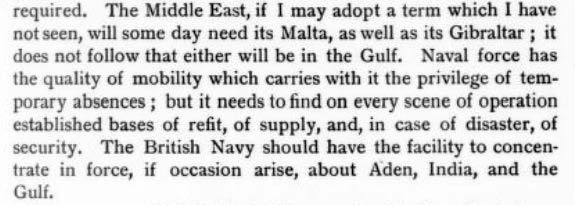
Source: Alfred Thayer Mahan, “The Persian Gulf and International Relations,” National Review, September 1902, pages 27-45.
Malta and Gibraltar were colonial outposts for British naval forces. According to Mahan, global naval forces would need similar colonial way stations in the Indian Ocean and the Persian Gulf. The term “Middle East” was rare enough that Mahan thought he had invented it.
In the mid-20th century, however, the Middle East migrated westward. The Middle East Studies Association, the preeminent professional association for the study of the region, defines its subject as ranging from Pakistan in the east to Morocco in the west, in keeping with map (d). Other definitions of the Middle East do not include Pakistan.
Some organizations, especially intergovernmental organizations, use the phrase “Middle East and North Africa” (MENA), in which the Middle East corresponds more to map (b), as distinct from North Africa. Map (c) covers the Arab League.
As an exercise, go to Wikipedia’s page on the Middle East and select various languages – what maps do they use?
3. What are the four most widely spoken indigenous languages in the Middle East?
Arabic is spoken primarily in North Africa, the Levant, and the Arabian Peninsula. Turkish and other Turkic languages are spoken primarily in Turkey, Azerbaijan, northwest and northeast Iran, and Central Asia. Urdu is spoken primarily in Pakistan, as well as in northern India. Persian (called Farsi in Persian) is spoken primarily in Iran and Afghanistan (where it is known as Dari), as well as Tajikistan (where it is known as Tajik).
English is also widely spoken in the region, as well as French (primarily in former French colonies), but the question asked about “indigenous” languages. Other languages in the region include Hebrew and Tamazight (formerly known as Berber), among others.
The location of these language communities is colorfully displayed in this pair of maps from the Gulf/2000 collection at Columbia University (which defines the Middle East as distinct from North Africa):
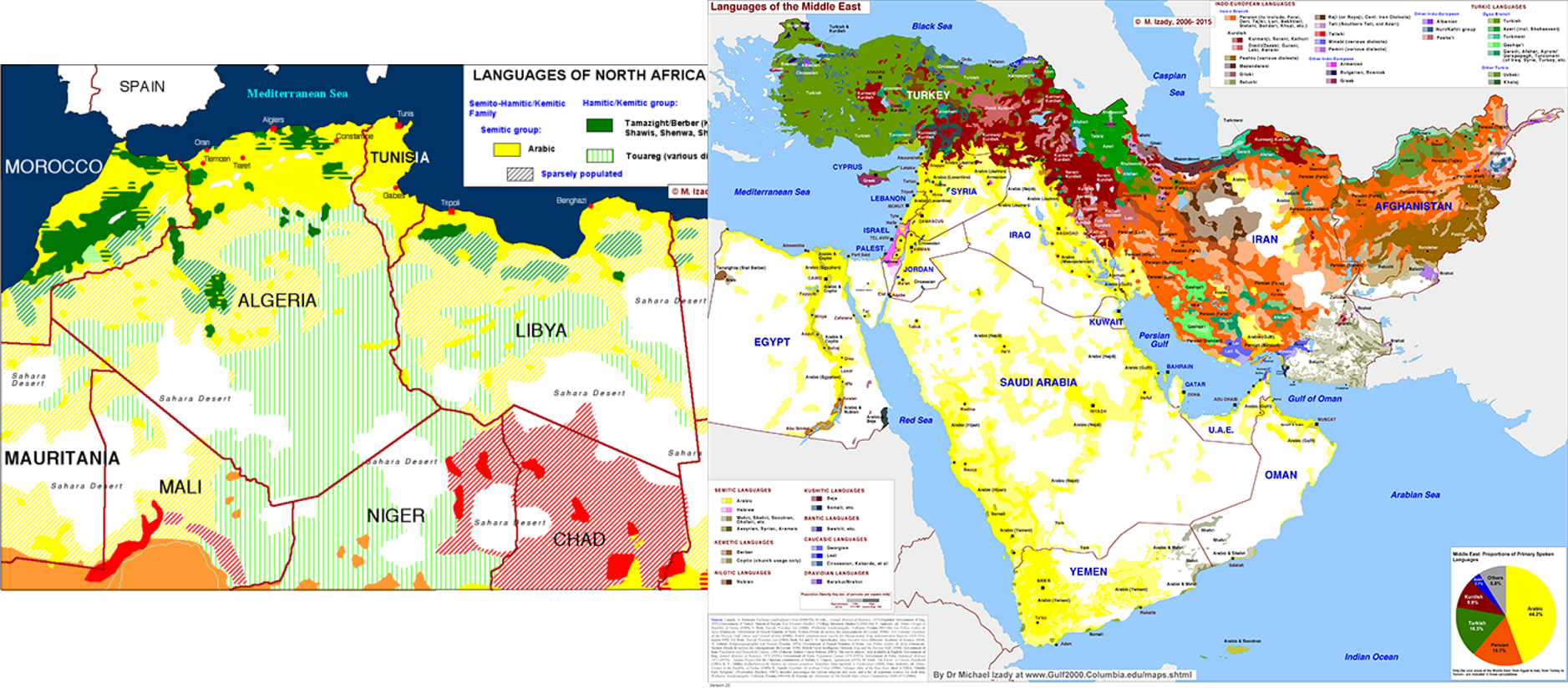
4. What percentage of the world’s Muslim population lives in the Middle East?
a) 10.4%
b) 30.1%
c) 41.2%
d) 61.9%
Without Pakistan, the answer would be (b) 30.1%: approximately 473 million. (Just under one quarter of the world’s human population of 6.8 billion is Muslim, according to the Pew report.)
Although Islam emerged in the Middle East – revealed by God to the Messenger Muhammad through the Angel Gabriel (Jibril in Arabic) beginning in 610 C.E., according to Muslims — most Muslims now live outside of the Middle East. This map, drawn by Christian missionaries a century ago, charts the approximate dates of the spread of Islam to various regions:
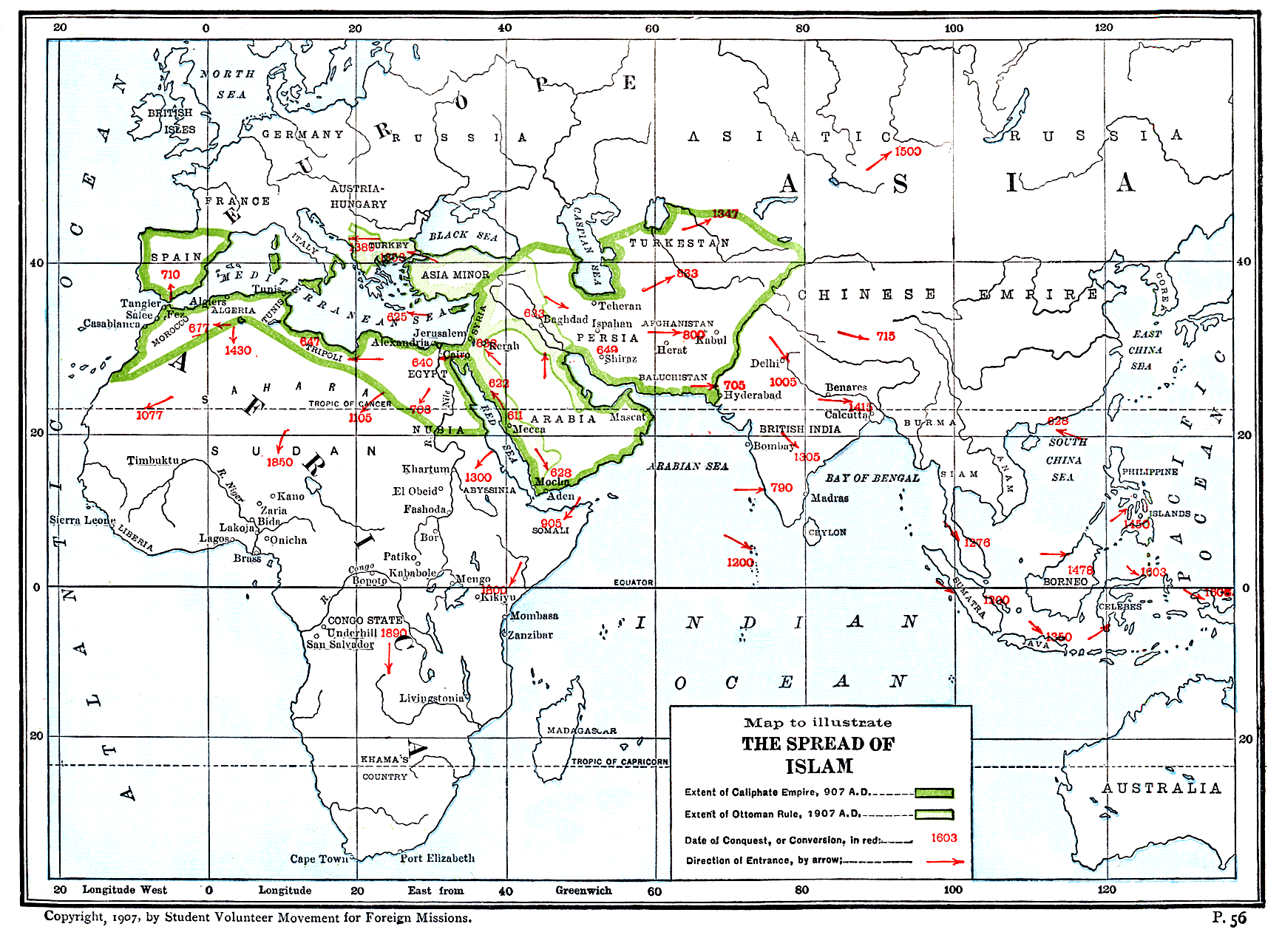 Source: Samuel M. Zwemer, Islam: A Challenge to Faith (New York: Student Volunteer Movement for Foreign Missions, 1907), fold-out map between pp. 56-57.
Source: Samuel M. Zwemer, Islam: A Challenge to Faith (New York: Student Volunteer Movement for Foreign Missions, 1907), fold-out map between pp. 56-57.
Follow-up questions: Perhaps you know which country has the largest percentage of the world’s Muslim population? Do you also know which countries are listed second, third, and fourth? Examine this map from the Pew Research Center’s report, Mapping the Global Muslim Population:
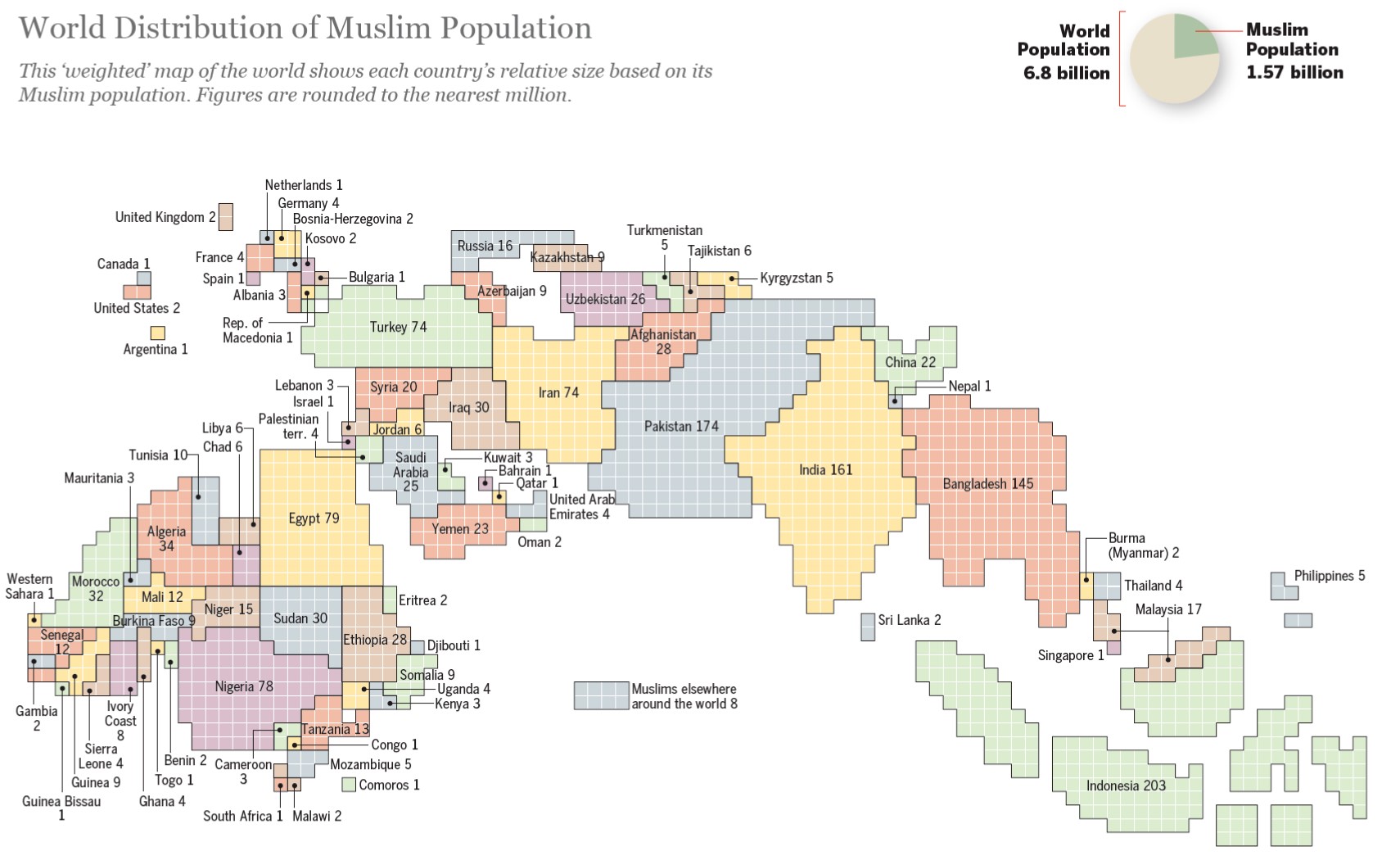
5. What percentage of the Middle East’s population is Muslim?
a) 85.5%
b) 93.0%
c) 99.1%
d) 99.9%
Data source: The Association of Religion Data Archives (ARDA), National Profiles, 2011 update.
Most of these religious minorities live along the eastern coast of the Mediterranean Sea, although there are significant Christian communities in Egypt and elsewhere, as well as longstanding Armenian Christian, Bahai, Jewish, and Zoroastrian communities in Iran.
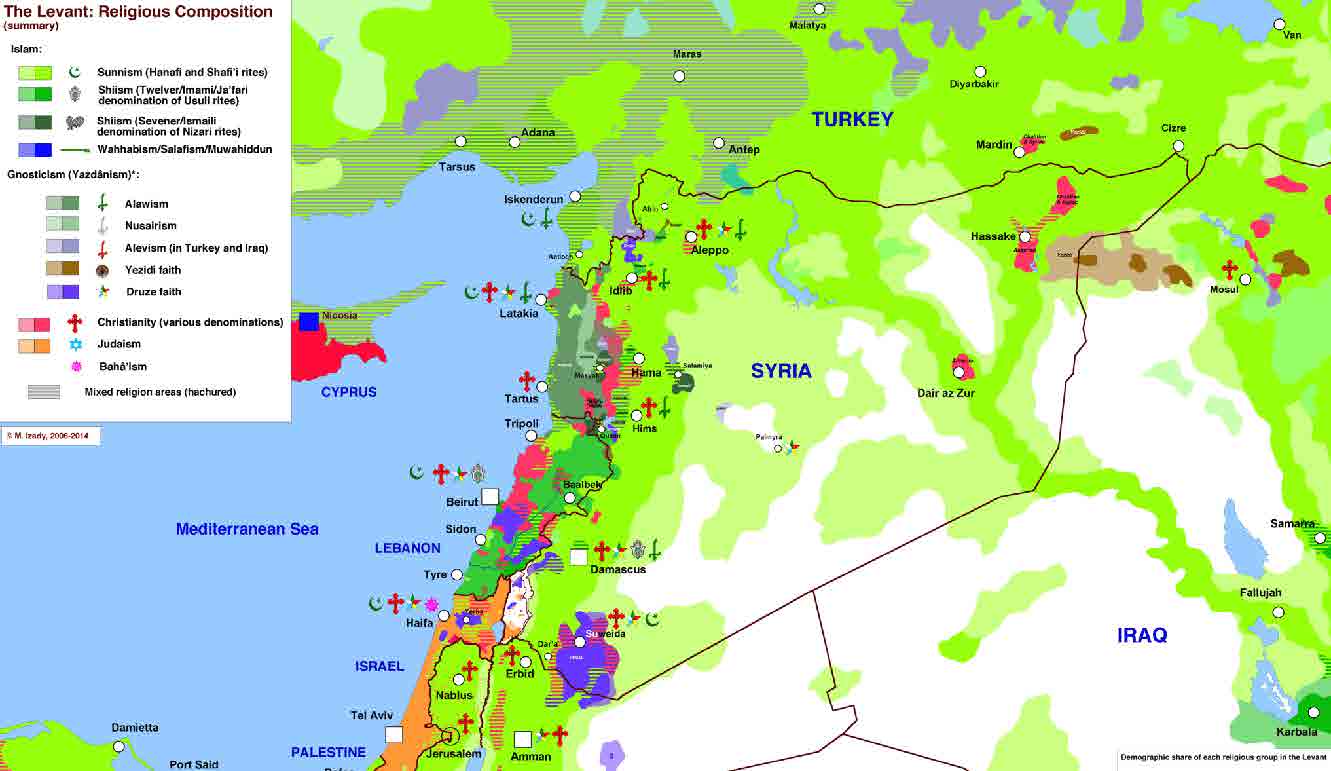 Source: M. Izady, from the Gulf/2000 map collection at Columbia University.
Source: M. Izady, from the Gulf/2000 map collection at Columbia University.
6. Which of the following statements about Sunni and Shia Muslims is/are true? (Check all that apply)
a) Approximately half of the world’s Muslims are Sunni and half are Shia.
b) Sunni and Shia Muslims follow five different pillars of Islam.
c) Sunni and Shia Muslims disagree about the succession of leadership after the Prophet Muhammad.
d) Sunni and Shia Muslims have been unable to live in mixed communities due to recurrent conflict.
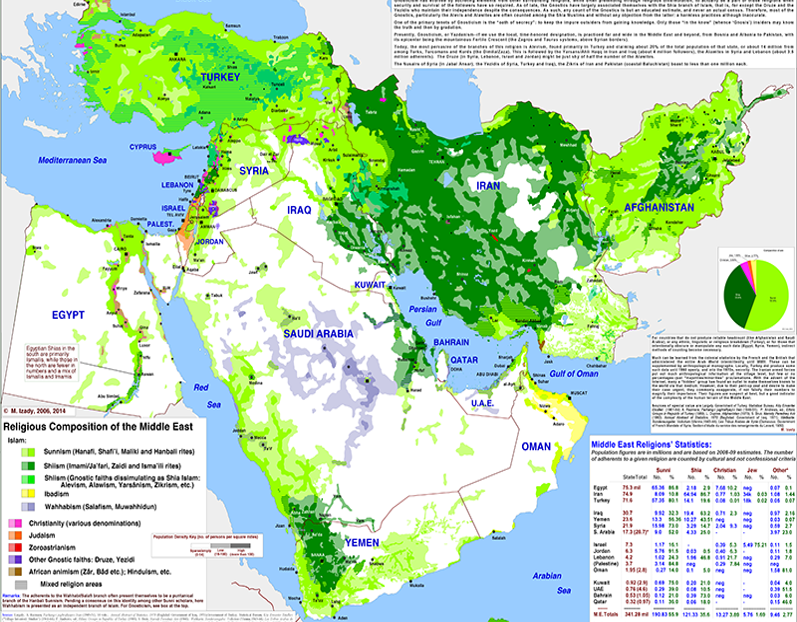
Note: This map, from the Gulf/2000 collection at Columbia University, treats Wahhabism as separate from Sunni Islam; this view is not widely shared among academics, who generally treat Wahhabism as a subset of the Hanbali school of Sunni Islam.
7. When did Israeli-Palestinian conflict begin?
a) Biblical times
b) The Crusades
c) After World War I
d) After World War II
Israeli nationalism, first known as Political Zionism, was invented by Theodor Herzl in 1896; Palestinian nationalism was invented around 1917, as the Ottoman Empire was dismembered in World War I. Periodic conflicts in the 1920s and 1930s predated the founding of Israel in the 1940s and the establishment of a partially autonomous Palestinian National Authority in the 1990s. This is not an ancient conflict.
Sources for further reading: David Vital, The Origins of Zionism (1976) (Archive.org; WorldCat.org); and Rashid Khalidi, Palestinian Identity: The Construction of Modern National Consciousness (1997) (Archive.org; WorldCat.org).
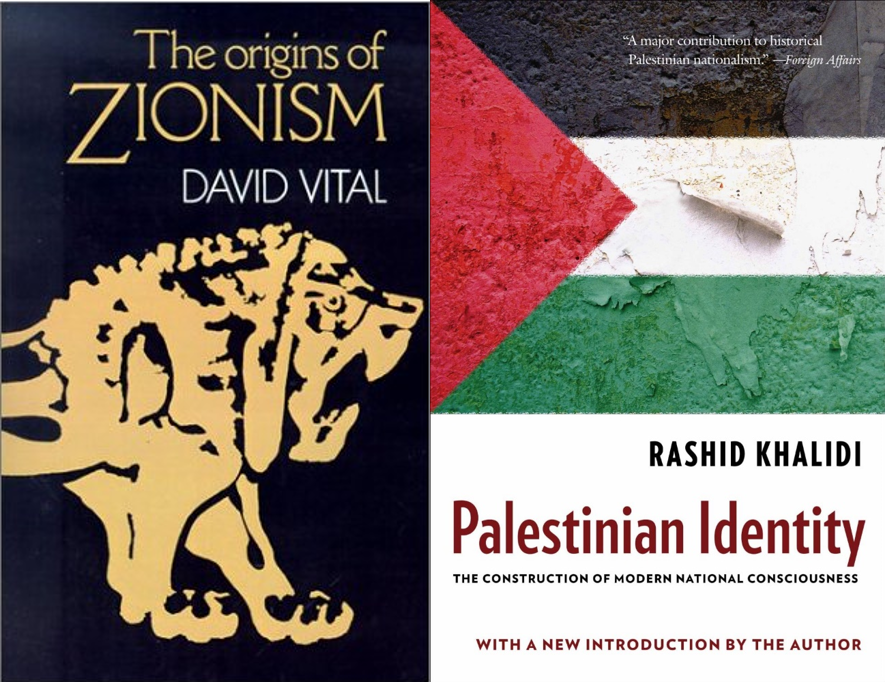
8. In which of the following Middle Eastern countries has the United States conducted armed interventions? (Circle all that apply)
a) Algeria
b) Iraq
c) Libya
d) Somalia
e) Syria
f) Yemen
Source: Barbara Salazar Torreon and Sofia Plagakis, “Instances of Use of United States Armed Forces Abroad, 1798-2022,” Congressional Research Service, March 8, 2022.

9. Which of the following Middle Eastern countries have sizeable oil reserves? (Circle all that apply)
a) Jordan
b) Saudi Arabia
c) Syria
d) United Arab Emirates
Source: U.S. Energy Information Administration, “Crude Oil Proved Reserves, 2018.” The map is now available in a different format.
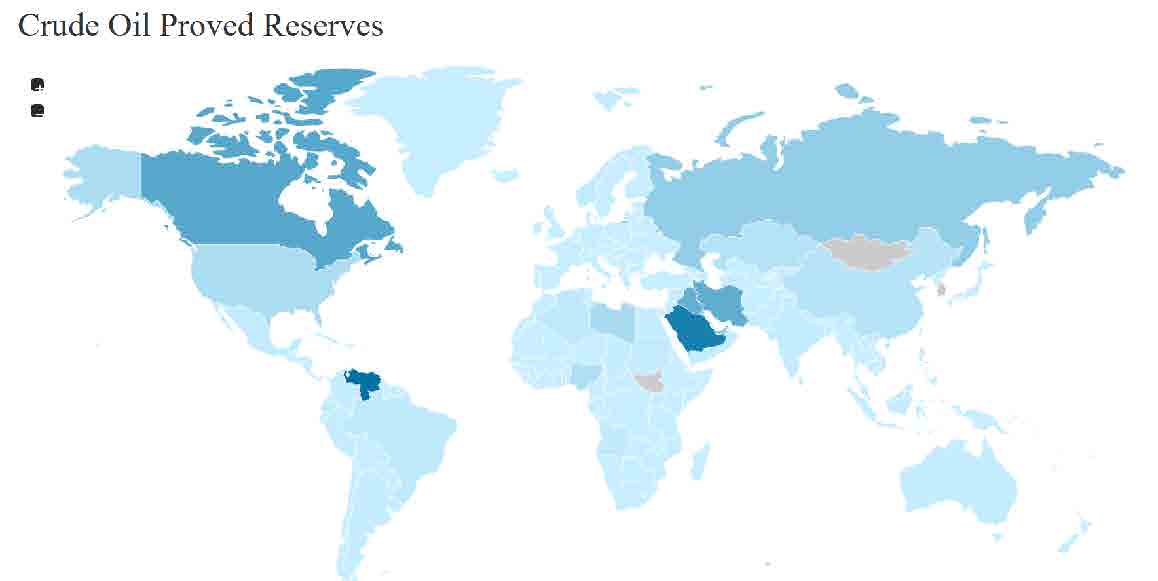
10. Between September 12, 2001, and the end of 2022, how many people in the United States were killed by Islamist terror attacks? (Out of the more than 300,000 Americans who were murdered during this period.)
a) 145
b) 541
c) 1,145
d) More than 5,000
Source: Charles Kurzman, “Muslim-American Involvement with Violent Extremism,” updated each January.
For more information on Islamist terrorism, and why there has been less of it than anticipated after the attacks of 9/11, please see my book The Missing Martyrs, Second Edition, Updated for the Age of ISIS (Oxford University Press, 2019).
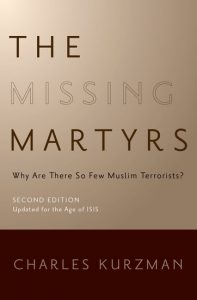
Bonus Question: How many of these were killed by extremists from the Muslim-majority countries whose U.S. visas were suspended in 2017 and 2020?
a) 0
b) More than 0

Source: Charles Kurzman, “These Numbers Show Why Trump’s Muslim Entry Limit Is Absurd,” Huffington Post, January 26, 2017.
There were also zero fatalities by Muslim extremists from the six countries added to the travel ban in early 2020: Eritrea, Kyrgyzstan, Myanmar, Nigeria, Sudan, and Tanzania.
Source: Charles Kurzman, “The 6 Countries in Trump’s New Travel Ban Pose Little Threat to US National Security,” The Conversation, February 6, 2020.
National origin is among the characteristics listed in the data spreadsheet on Muslim-American involvement with violent extremism, which is available on my website.